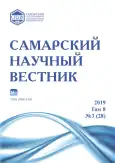«Рейды Палмера» – реакция на «красную угрозу» и роль Эдгара Гувера в мероприятиях министерства юстиции США
- Авторы: Левин Я.А.1
-
Учреждения:
- Самарский государственный социально-педагогический университет
- Выпуск: Том 8, № 3 (2019)
- Страницы: 211-214
- Раздел: Исторические науки и археология
- URL: https://journal-vniispk.ru/2309-4370/article/view/34377
- DOI: https://doi.org/10.17816/snv201983217
- ID: 34377
Цитировать
Полный текст
Аннотация
Статья посвящена реакции министерства юстиции США на Октябрьскую революцию 1917 г. в России и процесс, получивший в историографии наименование «красная угроза». Коренные изменения, произошедшие в России, идеи радикальной социальной справедливости, диктатуры пролетариата и мировой революции на фоне последних этапов Первой мировой войны привели к крайне негативному восприятию в США партии большевиков и их политики. Общий неприязненный настрой подогревался различными публикациями, обвиняющими В.И. Ленина и его соратников в связях с Германией (знаменитые «документы» Сиссона), различными публикациями в прессе и публицистике. Вместе с тем революция в России стала идейным маяком для анархистов и социалистов по всему миру, в том числе и в Америке. Особую активность проявила организация галлеанистов (последователей революционера и идеолога анархизма Луиджи Галлеани), ими в период с апреля по июнь 1919 г. организована целая серия взрывов, а также покушений на видных политиков, бизнесменов и даже сотрудников спецслужб США. В ответ на это генеральный прокурор Александр Митчелл Палмер инициирует серию силовых акций, направленных против всех левых партий и группировок в стране. Основным органом, занятым в этих акциях, стало Бюро расследований, довольно молодой следственный орган внутри министерства, не имевший чётких полномочий и страдавший от ряда проблем, как то: нехватка бюджета, процессуальные ограничения, кадровый голод и т.д. В статье проанализированы сами «рейды», проводимые БР, их особенности и последствия, а также карьерный путь и роль Джона Эдгара Гувера, будущего директора ФБР, на тот момент личного помощника Палмера.
Полный текст
Открыть статью на сайте журналаОб авторах
Ярослав Александрович Левин
Самарский государственный социально-педагогический университет
Автор, ответственный за переписку.
Email: yaroslavlevin1992@mail.ru
кандидат исторических наук, младший научный сотрудник кафедры всеобщей истории, права и методики обучения
Россия, СамараСписок литературы
- Holden H. FBI 100 Years. Minneapolis (MN). 2008. 252 p.
- Murray R.K. Red Scare: A Study in Nathional Hysteria, 1919–1921. Minneapolis (MN). 1955. 352 p.
- Gentry C.J. Edgar Hoover: The Man and the Secrets. N.Y., 1991. 848 p.
- Batvinis R.J. The Origins of FBI Counterintelligence. Lawrence (KS). 2007. 344 p.
- Greenberg I. Surveillance in America: Critical Analysis of the FBI, 1920 to the Present. Lanham (MD). 2012. 398 p.
- Karlitz G. FBI Agent. N.Y. 2009. 164 p.
- The FBI: A Comprehensive Reference Guide / Ed. by A. Theoharis. N.Y., 2000. 424 p.
- Ackerman K. Young J. Edgar: Hoover, the Red Scare, and the Assault on Civil Liberties. N.Y., 2005. 496 p.
- Crewe S. A History of the FBI. Bromall (PA). 2010. 64 p.
- Jeffreys-Jones R. FBI: A History. N.Y. 2007. 336 p.
Дополнительные файлы






